Marbled headstander - Abramites hypselonotus
Scientific name: Abramites hypselonotus
Common name: Marbled headstander
Family: Anostomidae
Usual size in fish tanks: 12 - 14 cm (4.72 - 5.51 inch)
014
Recommended pH range: 6 - 7.5
Recommended water hardness: 2 - 18°N (35.71 - 321.43ppm)
0°C 32°F30°C 86°F
Recommended temperature range: 22 - 28 °C (71.6 - 82.4°F)
The way how these fish reproduce: Spawning
Where the species comes from: South America
Temperament to its own species: aggressive/territorial
Temperament toward other fish species: peaceful
Usual place in the tank: Bottom levels
Origin
The Marbled headstander can be found extensively throughout South America, namely in countries such as Colombia, Peru, Brazil, Bolivia and Venezuela. This fish inhabits the river basins of the Amazon and Orinoco rivers and can also be found in the open waterways and floodplains during the rainy season.
Short description
The Marbled headstander gets its common name from its unusual habit of adopting a head standing position when feeding. Each specimen may well display unique markings within the group and they are classed as a peaceful species making them popular with many fish keepers but there are cases where adult fish do develop into fin nippers so be aware of this. Often sold as juveniles you can expect adult specimens to grow to an average length of up to 5.5 inches making them a reasonable size for medium sized aquariums.They belong to the group of characin species and have been listed as belonging to the family of Anostomidae.
Their body colouration can range from a darkish yellow to brown and this is broken with barring, spots and even broken bars in some cases giving them a camouflaged appearance. They do develop a deeper body shape compared to some of their characin cousins and with age their markings may fade to a grey.
Lifespan
If cared for correctly the Marbled headstander have quite a long average age, some specimens have been recorded to live up to the age of 15 years but the average is around the 10 year mark.
General care
The Marbled headstander can accept quite a wide range of water parameters compared to many species but they like like pristine water so always use a quality filtration system to keep these fish at their best. They should never be added to an immature tank set up as they will suffer if the water parameters fluctuate. These fish require a lot of swimming space so the smallest aquarium that should be used needs to be at least 4 feet (120 cm) in length and one foot (30 cm) wide. As mentioned they are happy in a wide range of water parameters, the temperature needs to be set between 20 - 30°C (68°F - 86°F). The pH needs to range between 6.0 - 7.5, slightly acidic water is their preference.
Rocks or wood can be added to the aquarium but this is optional as the are middle to top dwellers. If live plants are added you will find that they may nibble on the leaves.
Perform weekly water changes of at least 10%.
They are best housed with similar sized species such as cichlids and characins, to see the natural behaviour it is best to keep them in a small group of 3-4 specimens rather than a single specimen.
Feeding
The Marbled headstander are classed as an omnivorous species so will accept a wide range of foods. In the wild they forage on vegetation as well as insect larvae and small crustaceans. They will accept most commercial foods so offer a good quality flake or pellets for the staple diet but vary this with live or frozen foods. Bloodworms, brine shrimp or artemia are ideal. Extra vegetable matter can be supplied by offering spirulina flake, chopped zucchini or blanched peas.
Sexing
Mature females will develop a deeper body shape compared to mature males.
Breeding
There are no reliable reports of the Marbled headstander breeding in the aquarium but it is known that characins are usually egg scatterers and show no form of parental care. The eggs are often deposited amongst the vegetation to hide them away from predators.
Picture
Picture of Marbled headstander was bought by aqua-fish.net from jjphoto.dk.
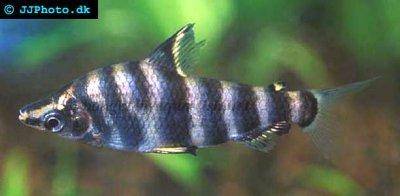

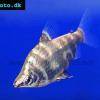 Abramites
Abramites 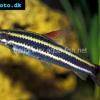 Striped
Striped 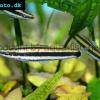 Goldstripe
Goldstripe  Headstander
Headstander 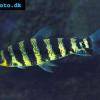 Black
Black